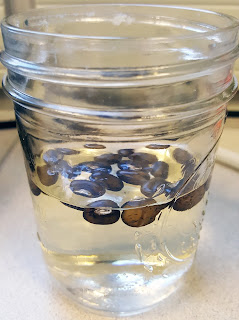Winter Project: Growing Wisteria from Seed
From the shape and size of these
wisteria seeds, I’m guessing they’re from a mature Chinese - not Japanese -
wisteria. Today they’re soaking in warm water. Tomorrow, they’ll be planted.
Back
in September, a friend had questions about wisteria. Her mother has beautiful
vines perched on a pergola at her house. The vines were producing what look
like runner beans, and she was wondering if these pods were the plant’s seeds.
The
pods you see hanging by the hundreds, sometimes thousands, from a mature or
even juvenile wisteria are the plant’s seed pods: each pod contains from one up
to six seeds. The pods develop during summer, mature in fall, and in large
numbers, burst open in October. The seeds are dispersed, and given the right
conditions, germinate.
So, my
friend wants to grow wisteria from these seeds. Well, I got excited too, and
asked her to wait until early winter, after the pods have dried and turned
brown, to pick them and share a few with me. This morning, she brought me a bag
of about a hundred pods.
Although
I know as much about wisteria as a UConn certified master gardener should –
which is to say a lot - this is my first try at germinating wisteria from seed.
I know that the hard seed capsules must be soaked first in water, preferably
spiked with a little hydrogen peroxide. I know that they take some time to
germinate, but are fast growers once they get going. Wisteria needs at least 6
hours of sun a day. And if you’re really committed to doing it right, you must
build or buy a large, sturdy pergola for the vines to weave their way through.
I also
know that it will take up to 15 years for these seeds to become fully mature
wisteria vines – the magnificent kind you see in the southern part of the U.S.,
in places like Savannah. The flowers hang like fairy lights on large tendrils,
and depending on the variety of wisteria floribunda you have, are a combination
of soft purple, white, violet, yellow, and/or pink.
The
Japanese variety features more pink in the flower, and a lighter bark with
spots of white. The Chinese variety is almost purely purple and white, with a
darker bark. Based on the shape of the seeds my friend gave me, we have the
seeds from a Chinese wisteria. But I asked her to bring me a summer photo of
the flowering plant so I can confirm that. She has one and is going to send it
my way.
I’ve
placed about 20 of the seeds in a glass of warm water. They’ll soak until
tomorrow, and then I’ll go with the plastic bag method of germination. I’m
going to stratify another 20 or so seeds in the refrigerator until late spring,
when I’ll plant them in pots outdoors. And I think I’ll take another 20 or so
and nick the hard seed shell, then soak, and then plant in soil.
This
will increase threefold my chance of successfully germinating the seeds. And although
this is a long-term commitment, and I will likely never enjoy the vines in their
glory, someone else will, and that’s good enough for me.
Live
in peace.


